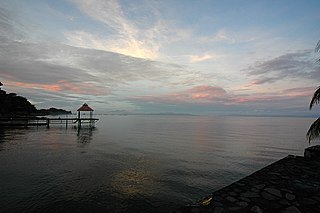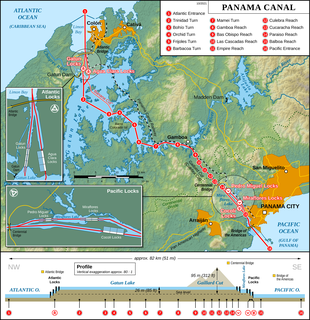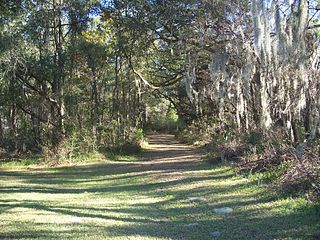Related Research Articles

Lake Nicaragua or Cocibolca or Granada is a freshwater lake in Nicaragua. Of tectonic origin and with an area of 8,264 km2 (3,191 sq mi), it is the largest lake in Central America, the 19th largest lake in the world and the tenth largest in the Americas, slightly smaller than Lake Titicaca. With an elevation of 32.7 metres (107 ft) above sea level, the lake reaches a depth of 26 metres (85 ft). It is intermittently joined by the Tipitapa River to Lake Managua.

Nicaragua, officially the Republic of Nicaragua, is the largest country in the Central American isthmus, bordered by Honduras to the northwest, the Caribbean to the east, Costa Rica to the south, and the Pacific Ocean to the southwest. Managua is the country's capital and largest city and is also the third-largest city in Central America, behind Tegucigalpa and Guatemala City. The multi-ethnic population of six million includes people of indigenous, European, African, and Asian heritage. The main language is Spanish. Indigenous tribes on the Mosquito Coast speak their own languages and English.

The Nicaraguan Canal, formally the Nicaraguan Canal and Development Project was a proposed shipping route through Nicaragua to connect the Caribbean Sea with the Pacific Ocean. Scientists were concerned about the project's environmental impact, as Lake Nicaragua is Central America's key freshwater reservoir while the project's viability was questioned by shipping experts and engineers.

The Panama Canal is an artificial 82 km (51 mi) waterway in Panama that connects the Atlantic Ocean with the Pacific Ocean. The canal cuts across the Isthmus of Panama and is a conduit for maritime trade. Canal locks are at each end to lift ships up to Gatun Lake, an artificial lake created to reduce the amount of excavation work required for the canal, 26 m (85 ft) above sea level, and then lower the ships at the other end. The original locks are 32.5 m (110 ft) wide. A third, wider lane of locks was constructed between September 2007 and May 2016. The expanded canal began commercial operation on June 26, 2016. The new locks allow transit of larger, neo-Panamax ships, capable of handling more cargo.

The Saint Lawrence Seaway is a system of locks, canals, and channels in Canada and the United States that permits oceangoing vessels to travel from the Atlantic Ocean to the Great Lakes of North America, as far inland as Duluth, Minnesota, at the western end of Lake Superior. The seaway is named for the Saint Lawrence River, which flows from Lake Ontario to the Atlantic Ocean. Legally, the seaway extends from Montreal, Quebec, to Lake Erie, and includes the Welland Canal.
Paddington Basin is the name given to a long canal basin, and its surrounding area, in Paddington, London.

The Cross Florida Barge Canal, now officially the Marjorie Harris Carr Cross Florida Greenway is a protected green belt corridor, more than one mile (1.6 km) wide in places. It is named for the leader of opposition to the Cross Florida Barge Canal, Marjorie Harris Carr, and was originally a U.S. Army Corps of Engineers canal project to connect the Gulf of Mexico and the Atlantic Ocean across Florida for barge traffic. Two sections were built but the project was ultimately cancelled, due to local opposition related to environmental concerns, including protecting the state's water supply and conservation of the Ocklawaha River Valley ecosystem, but also due to national opposition for the costs being perceived as "government waste" with "limited national value."

Sabarmati Riverfront is a waterfront being developed along the banks of Sabarmati river in Ahmedabad, India. Proposed in the 1960s, the construction began in 2005. Since 2012, the waterfront is gradually opened to public as and when facilities are constructed and various facilities are actively under construction. The major objectives of project are environment improvement, social infrastructure and sustainable development.
The Nicaraguan Ecocanal is a proposed project in Nicaragua to build a shallow-draft waterway connecting the inland Lake Nicaragua with the Caribbean Sea via the San Juan River in the south of the country. The main aim of the waterway is to provide a maritime alternative to the lengthy overland journeys that are presently required to import and export containerised cargoes through the ports of Puerto Cortes in Honduras and Puerto Limon in Costa Rica.

The Rama are an indigenous people living on the eastern coast of Nicaragua. Since the start of European colonization, the Rama population has declined as a result of disease, conflict, and loss of territory. In recent years, however, the Rama population has increased to around 2,000 individuals. A majority of the population lives on the island of Rama Cay, which is located in the Bluefields Lagoon. Additional small Rama communities are dispersed on the mainland from Bluefields to Greytown. The Rama are one of three main indigenous groups on Nicaragua’s Caribbean coast.
Water resources management in Nicaragua is carried out by the National water utility and regulated by the Nicaraguan Institute of water. Nicaragua has ample water supplies in rivers, groundwater, lagoons, and significant rainfall. Distribution of rainfall is uneven though with more rain falling on an annual basis in the Caribbean lowlands and much lower amounts falling in the inland areas. Significant water resources management challenges include contaminated surface water from untreated domestic and industrial wastewater, and poor overall management of the available water resources.

The Weavers' Triangle is an area of Burnley in Lancashire, England consisting mostly of 19th-century industrial buildings at the western side of town centre clustered around the Leeds and Liverpool Canal. The area has significant historic interest as the cotton mills and associated buildings encapsulate the social and economic development of the town and its weaving industry. From the 1980s, the area has been the focus of major redevelopment efforts.

The Irtysh–Karamay–Ürümqi Canal, also known as the Project 635 Canal, is a system of water-transfer canals and reservoirs in the northern part of China's Xinjiang Uighur Autonomous Region. It transfers water from the Irtysh River into several dry endorheic basins of north-central Xinjiang, where it is used for irrigation and general use of the population and industries.
Wang Jing is a Chinese businessman. He is the Chairman and CEO of Beijing Xinwei, a Chinese telecoms company. Among his major interests is the HK Nicaragua Canal Development Investment (HKND) that manages the Nicaraguan Canal and Development Project to build the Nicaragua Canal.
HK Nicaragua Canal Development Investment Co., Ltd. also known as HKND was a private infrastructure development firm that is registered in Hong Kong. HKND was founded in 2012 with the purpose to develop the Nicaragua Canal as a wider and deeper alternative to the Panama Canal. HK Nicaragua Canal Development Investment is owned or controlled by the Chinese businessman Wang Jing. In 2014 it was announced that an IPO is being prepared to provide financing for the project but following financial difficulties, HKND finally closed its offices in April 2018.
The Punta Gorda River is a river in eastern Nicaragua. It originates in the Caribbean highland and flows east to enter the Caribbean Sea at Punta Gorda. Part of the river's drainage area is the protected Punta Gorda Natural Reserve.

There is a long history of attempts to build a canal across Nicaragua to connect the Atlantic Ocean with the Pacific Ocean. Construction of such a shipping route—using the San Juan River as an access route to Lake Nicaragua—was first proposed in the early colonial era. Napoleon III wrote an article about its feasibility in the middle of the 19th century. The United States abandoned plans to construct a waterway in Nicaragua in the early 20th century after it purchased the French interests in the Panama Canal. The Panama Canal was built and that is now the main connecting route across Central America.

The 2014–2020 Nicaraguan protests are a series of protests against Nicaraguan President Daniel Ortega and actions performed by his government, the dismantling of the opposition and oppressive human rights violations against peaceful protesters.

Hong Kong–Nicaragua relations refers to the bilateral relationship between Hong Kong and Nicaragua.
References
- ↑ Nicaragua Canal Project Description (HKND Group, dated December 2014) at the Wayback Machine (archived 2018-08-28)
- ↑ Tracy Wilkinson (September 9, 2014). "Secrecy and Doubt Shroud Nicaragua's Huge Canal Plans". Los Angeles Times . Retrieved January 16, 2015.
Coordinates: 11°20′39″N85°58′45″W / 11.3443°N 85.9793°W
| This article related to a river in Nicaragua is a stub. You can help Wikipedia by expanding it. |